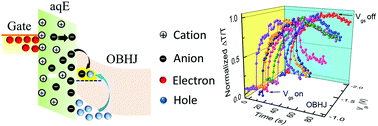In situ probing electronic dynamics at organic bulk heterojunction/aqueous electrolyte interfaces by charge modulation spectroscopy†
Abstract
Interfacing an organic bulk heterojunction (OBHJ) with an aqueous electrolyte (aqE) solution has the potential for applications in biological sensing and neuronal stimulus, by taking advantage of the benefits of the high excitation efficiency and biocompatibility of the OBHJ. At the OBHJ/aqE interface, local charge transfer and transport processes, which are influenced by the polymer/fullerene interface and ion migration, are critically important for device performance but poorly understood. Here, we have introduced charge modulation spectroscopy (CMS) in aqE-gated heterojunction transistors to in situ investigate electronic dynamics at the OBHJ/aqE interface. By correlating impedance spectroscopy measurements and the gating-voltage dependence of the mobility, we show that the existence of local disordered structures, caused by an intermixed fullerene phase, can induce electrochemical doping effects with ion injections. These ions will be trapped in fullerene domains, thus limiting carrier transports via strong carrier–ion interactions with ion-induced trapping. However, carrier–ion interactions have little influence over the charge transfer process due to the existing large energy-offset between the polymer and the fullerene. Furthermore, time-resolved CMS responses reveal that carrier–ion interactions can induce obvious perturbations in polaron relaxations. Our findings provide possibilities for the design and manipulation of novel and low-cost sensing systems for future bio-recognition devices.



 Please wait while we load your content...
Please wait while we load your content...